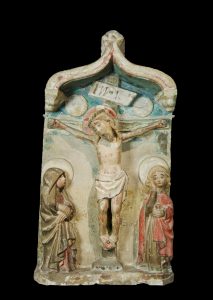
Calvary
Author: Unknown
Date: 15th century
Material: Polychromed limestone
Dimensions (cm): H 105 x W 55 x D 22
Provenance: Unknown
Owner: Lisbon, Museu Nacional de Arte Antiga, Coleção Comandante Ernesto Vilhena
Inventory No.: MAS ED 67
Rectangular piece crowned with an ogee arch, with the representation of the crucified Christ, flanked by Saint John the Evangelist with an aureole, with the right hand on the face, and by the Virgin, also with an aureole, wearing a tunic and a mantle that covers her head. The Sun and the Moon are depicted on the upper corners.
The theme of the Calvary is referred to by all the evangelists – Saint Matthew, Saint Mark, Saint Luke and Saint John – and was artistically represented throughout the centuries.
The Gospel of Saint John records the Crucifixion of Jesus in the following way: “Carrying his own cross, Jesus went out to the place of the Skull, which in Aramaic is called Golgotha where they crucified him, and with him two others, one on each side and Jesus in the middle. Pilate had a notice prepared and fastened to the cross. It read: ‘Jesus of Nazareth, the King of the Jews.’” (Jo 19: 17 – 19)
“[…] Near the cross of Jesus stood his mother, his mother’s sister, Mary the wife of Clopas, and Mary Magdalene. When Jesus saw his mother there, and the disciple whom he loved standing nearby, he said to her, ‘Woman, here is your son!’ and to the disciple, ‘Here is your mother!’ From that time on, this disciple took her into his home…” (Jo 19: 25 – 27)
Based on the biblical accounts, this representation of the Calvary organizes around the figure of the crucified Christ and it depicts the presence of Mary and John the Evangelist as well as the notice with the initials INRI that were put on the cross following Pilate’s order.
